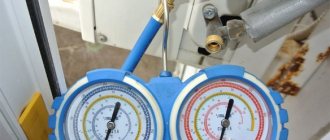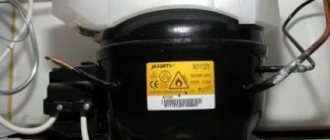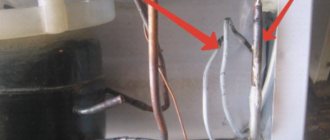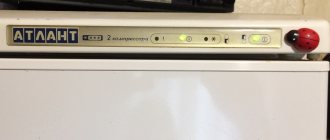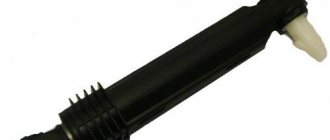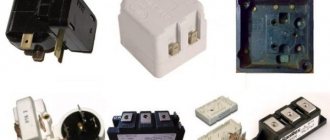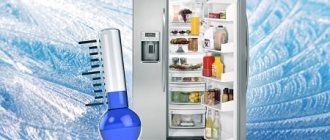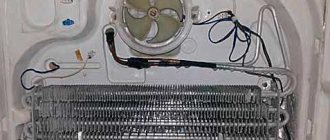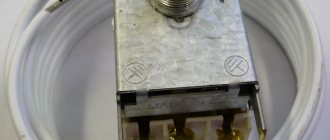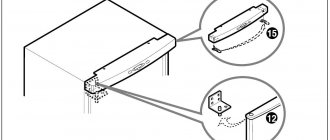What freons are used in refrigerators
Residential and commercial refrigerators have used different refrigerants at different times. Here's the full list:
- R-717 (Ammonia);
- Sulfur dioxide;
- R-40 (Methane chloride);
- R-12 (Difluorodichloromethane);
- R-134a (1,1,1,2-Tetrafluoroethane);
- R-600a (Isobutane);
- R-290 (Propane).
Rare gases can be found in some refrigerators. They are a makeshift replacement for the traditional ones. Sometimes craftsmen use them with a slight upgrade of the system. The most common refrigerants are:
- R-22 (Difluorochloromethane);
- R-502;
- R-406.
Freon leak in the refrigerator: signs
There are 9 signs of a freon leak in the refrigerator:
- The equipment does not cool well;
- The compressor turns on frequently and runs constantly.
- During operation, extraneous sounds appeared (hissing, whistling, gurgling);
- A spot of snow, ice or frost has formed on the wall (internal or external);
- The radiator on the rear wall is at room temperature;
- The compressor does not turn on;
- Constant malfunction signals (refrigerator beeps, LED flashes);
- Tubes near the compressor are frozen;
- Bulging of the wall (inside or outside).
If one of the symptoms appears, this does not guarantee a refrigerant leak. Problems at work can be different. Therefore, you need to know how to determine a freon leak in a refrigerator. We will divide all work to eliminate freon leaks in the refrigerator into three stages and consider them sequentially:
- Finding the location of the refrigerant leak;
- Finding the cause (so that the situation does not happen again);
- Troubleshooting.
Banned R-12
According to its characteristics, freon R12 is one of the most efficient refrigerants. It was used in car air conditioners in the West. Also used in almost all Soviet refrigerators, such as:
- Dnieper;
- Minsk;
- ZiS and ZiL;
- Smolensk;
- Biryusa;
- And in many others.
This refrigerant has a high ozone depletion potential. Therefore, its use was regulated by the Montreal Protocol on Substances that Deplete the Ozone Layer of 1987.
According to the protocol, the production of the refrigerant has been prohibited in developed countries since 1996, in developing countries since 2010. It is allowed to be used only as a fire extinguishing agent in submarines and aviation.
What works in modern refrigerators
Manufacturers use the following refrigerants: R12, R22, R134a, R600a. You can find out which of them circulates in your refrigerator in the technical characteristics of the unit or by looking at the compressor (there is a tag indicating the type of freon) . I would like to note right away that the volume that circulates along the circuit cannot cause a fire, explosive situation or explosion.
However, there is still potential harm:
- R12 – difluorodichloromethane is almost never used in modern technology. The refrigerant can only be found in old refrigerators like the pot-bellied Zil. It is a non-explosive, colorless gas, not flammable. There is a slight ether-like smell. However, this thing is very harmful to the environment, as it destroys the ozone layer (this fact has not been fully proven to this day). Danger to humans can only arise in high concentrations: if the volume of gas in the air exceeds 30%, there is a risk of suffocation . However, even if all the refrigerant leaves the refrigerator circuit, it will not cause such a concentration. It can be added that at temperatures above 300 degrees, freon begins to release toxic substances, but this is also unlikely in everyday life;
- R22 is also difluorochloromethane. It is clear that today it only works in older models, although it was previously very common. R22 refrigerant is a light gas, colorless, but with a faint odor of chloroform. It is not explosive, not flammable, and not as harmful to the ozone layer as its previous comrade. The potential harm is that when exposed to high flame, it decomposes into toxic products . In fact, to feel all the toxicity of freon, you need a fire with heating above 250 degrees;
- R134 a – tetrafluoroethane is widely used in household refrigerators. This is practically the first freon in which the use of chlorine was abandoned. According to its characteristics, it is a colorless, non-toxic gas. The advantage is that it does not ignite or explode at any temperature. This thing is absolutely safe , even for the long-suffering ozone layer (hello, defenders of the planet). The downside is that it works in tandem with synthetic oil, which often leads to clogging of the capillary pipeline;
- R600 a – isobutane. Perhaps everyone knows this refrigerant, since it is what is used in most modern refrigerators. It does not destroy the ozone layer, but this natural gas is insidious - in high concentrations it becomes explosive when exposed to air . I just want to warn you that this must be a very high concentration. The explosion hazard threshold for isobutane is 1.3%. To do this, for each m3 of room there should be 31 g of refrigerant, in terms of the entire standard kitchen - this is about 400 g. In any refrigerator there is no more than 100-200 g of freon. A potential risk arises only when a leak occurs immediately in an absolutely sealed room in 2-4 refrigerators.
We can say that in the volumes that work in modern technology and at room temperature, refrigerants do not cause harm to humans . However, against the background of a leak, ventilation should not be neglected.
R-134a
R-134a refrigerant was developed as an alternative to the banned R-12. It does not have such good characteristics, in particular cooling capacity. Its operation requires not mineral, but more expensive, synthetic oil.
R134-a is non-flammable and non-toxic. Its ozone depletion potential ODP is 0. Global warming potential GWP is 1430. This is 5.65 times less than R12 freon. Areas of application of R134a refrigerant:
- Car air conditioners;
- Refrigerators;
- Medium temperature freezers;
- Solvent in organic chemistry;
- Plastic foamer;
- Aerosol filler.
What to do
If there is a freon leak (or a decrease in the refrigerator’s performance), it is necessary to stop the equipment and unload the freezers from food. After removing any remaining ice and water, it is recommended to flush the refrigeration equipment and then begin searching for the location of the circuit damage. Finding the location of the breakdown is the only manipulation that the owner is recommended to do independently. Complete and high-quality restoration of a refrigeration unit in domestic conditions is impossible; it is recommended to carry out repairs in specialized workshops.
If gas has flowed through damaged solder joints, you will need to restore the connection point with a blowtorch or a powerful electric soldering iron. To repair a damaged condenser, you will have to disassemble the back wall of the equipment and then remove the heat insulation layer. Repairing some components is not economically feasible; the products are replaced with elements from similar equipment or with new parts supplied by the manufacturer to service centers.
Instead of leaking freon from the refrigerator, the technician refills it with a new substance. To replenish the gas supply, special equipment is used to provide the necessary pressure and pour oil into the compressor crankcase. Before starting work, the lines are filled with neutral gas (nitrogen), and the absence of leaks is checked using the pressure gauge. Before filling the system with refrigerant, air is pumped out of the pipelines and water vapor is removed. After completing the refueling procedure, the refrigerator is turned on to check its functionality.
R-600a, isobutane
This refrigerant has been used since the early 20th century in refrigerators and freezers. But after the appearance of the R12, it was forgotten for many years. It was reused in 1993. Its characteristics are similar to R134a refrigerant. But it has a number of differences. Previously, we looked at the topic of which refrigerant is better, R134a or R600a.
R600a refrigerant has an ozone depletion potential ODP of 0. Global warming potential GWP is less than 0.001. However, it works with mineral oils. The only drawback is the relatively high flammability.
Interesting fact
In some countries, it is prohibited to use isobutane to refill refrigerators, for example, in the USA. All refrigeration and freezing equipment produced there runs on R-134a or R-290. Manufacturers of these refrigerants are lobbying for the ban in order to capture sales markets.
The role of freon in the operation of a refrigerator
If the compressor is considered by some to be the heart of the refrigerator, then the refrigerant can be considered its blood. Without a sufficient amount of this substance, no refrigeration equipment will be able to operate. The colorless and odorless gas is necessary to transport thermal energy.
Freon easily passes from liquid to gaseous state at relatively low temperatures. The circuit through which it circulates consists of two parts: internal and external.
The liquid refrigerant enters the internal circuit of the refrigerator and absorbs particles of thermal energy dissipated in the air, turning into gas. It then moves to the external circuit, passes through the compressor and evaporator, transfers heat to the surrounding air and returns to liquid form.
The cycle repeats again and again, as a result, the air in the refrigerator chamber becomes colder, and the grille on the back wall constantly releases heat.
To refill the refrigerator with freon, you will need a filling station, a set of special tools and materials, as well as a refrigerant cylinder
These properties of freon are also used in other devices, such as air conditioners, heat pumps, etc. Gas circulates through a hermetically sealed circuit. It does not pose a great danger to human health even if the substance completely leaks from an ordinary household refrigerator.
In total, 16 types of these saturated fluorinated hydrocarbons are used in industry. A specific brand of freon is suitable for refilling a specific refrigerator model; it is usually indicated directly on the compressor housing.
R-290
The R290 freon label hides regular propane. Recently, it has begun to be considered as an alternative to traditional refrigerants. The characteristics of R290 refrigerant allow it to be used in domestic and commercial refrigeration installations.
The ozone depletion potential ODP of R290 refrigerant is 0. The global warming potential GWP is 3. It is used with polyolester synthetic oils. Its characteristics and chemical activity are similar to R600a.
In 1994, the production of household refrigerators using R290 refrigerant or its mixture with R600a began. More than 1000 pieces were produced in Germany. Since then, the following countries have been actively producing them:
- Argentina;
- Brazil;
- India;
- China;
- Türkiye;
- Chile.
Refrigerator refrigerant: what to choose?
Today, many European and Russian manufacturers of household appliances are switching to ozone-safe substances, which include the modern R600a refrigerant. It is not only safe for the environment, but also eliminates the possibility of fire, which cannot be said about many of its analogues. In addition, the R600a powers the most energy-efficient refrigerators of classes A+ and A++.
R134a refrigerant also does not contain ozone-depleting chlorine, but it is less energy efficient. In addition, capillary tube blockages are more common in refrigerators with R134a. And yet, today refrigerators with this refrigerant are more accessible to the average consumer.
Older models used R12 refrigerant, which has high thermal performance. Today, refrigerators with such a refrigerant are almost impossible to find.
As a conclusion, we note: look for refrigerators with R600a refrigerant - it is the one that currently fully complies with almost all safety requirements.
Environmental benefits of R600a
- It contains no synthetic components;
- reduced noise level of BHP;
- does not have ozone depletion properties (coefficient (ODP = 0);
- low potential for impact on the greenhouse effect (GWP = 0.001).
Thermodynamic advantages of R600a
- It has a higher (for example, than R12) refrigeration coefficient, which reduces the energy consumption of the BHP;
- hydrocarbons (isobutane and propane-butane mixtures) can be used in existing compressor designs.
R600 performance benefits;
- Relatively stable gas (the estimated service life of the BCP is more than 20 years);
- is a pure (simple) substance;
- soluble in mineral oil;
- there is a possibility of use in mixed refrigerants (C1=R152+R600a; R290/R600a; M1LE=R22/R142b/R600; R218/R600a). This makes it possible to achieve parameters of the mixed refrigerant close, for example, to the previously used R12. In turn, such a replacement makes it possible to simplify the process of retrofitting (converting existing equipment to work with ozone-safe refrigerants) of systems;
- natural hydrocarbons, as refrigerants, have not been widely used in BHP due to the increased fire hazard.
In modern designs, this problem has been solved by reducing the filling dose to such volumes that practically cannot lead to a fire. The refill dose for household refrigerators and freezers is so small that even if there is a sudden and complete leak of refrigerant from the unit, its concentration in a kitchen with a volume of 20 m3 will be tens of times lower than the flammability threshold.
Economic advantages of R600a
- The mass of refrigerant circulating in the refrigeration unit when using isobutane is significantly less;
- there are plants for the production of commercial quantities of isobutane (in relation to Russia, isobutane fractions are produced by Tuymazinsky and Shkapovsky production facilities);
- the most economical refrigerators with energy consumption classes A+ and A++ run on R600a.
Thermodynamic disadvantages of R600a
- Low solubility in water (0.03 g/l at 20°C);
- does not enter into chemical reactions with water;
- low specific volumetric cooling capacity (2 times lower than that of R12).
Operational disadvantages of R600a
- It practically does not allow retrofitting of existing equipment without significant changes in the design of the refrigeration unit and electrical equipment of the BHP;
- gas is colorless and odorless, which makes it difficult to detect;
- due to the fact that isobutane is heavier than air, when accumulated indoors it can cause asphyxia (suffocating properties);
- is explosive, charging with this refrigerant can only be carried out by specialists from service centers who have undergone special training in working with R600a. This property imposes restrictions on the repair of such devices outside of specialized workshops.
Economic disadvantages of R600a
- The need to use a fundamentally new fleet of expensive operational and repair equipment;
- the need to carry out developments taking into account the fire hazard of the refrigerant.
Properties and characteristics of isobutane
- Isobutane (R600a) is a colorless and odorless gas, chemical formula CH(CH3) 3 or C4H10.
- The physical properties of isobutane are given in Table 1.
- Requirements for isobutane used in the refrigeration industry are given in table. 2.
- When compared with refrigerants R12 and R134a, isobutane evaporates and condenses at lower pressures (at the same temperatures) - see table. 3.
As noted above, the R600a refrigerant is fire hazardous, therefore, when carrying out preventive and repair work on the BHP, different equipment and materials are used than when working with conventional refrigerants.
Let's look at the features of charging R600a refrigerant into the BHP system, the method of “cold” connecting pipes using the LOKRING method, and list the necessary devices and tools when working with isobutane.
Table 1. Physical properties of isobutane
Table 2. Requirements for isobutane used in BHP
Table 3.
Yuri / 19.10 If you use it as fuel, then you can go the route of cylinders for household purposes, they use a propane/butane mixture. Pour in the propane-butane mixture from cylinders, the volume of gas depends on the tank itself, but I think one 40-liter household cylinder will be enough to create the required vapor pressure. Well, or wait until it warms up)
Sergey / 18.12 Liquefied isobutane is in an underground tank. As the temperature decreases, the pressure in it correspondingly decreases to 0.1 mPa. The pump, which normally pumps gas out of the reservoir at other times of the year, now “grabs” the gas phase and becomes airborne. Accordingly, it cannot create the necessary pressure. Installing a higher-capacity pump did nothing. Similar pumps pumping gas from above-ground tanks operate without problems under the same conditions. Is there a solution to this problem without forcibly increasing the pressure of the vapor phase in the tank?
R-1234yf (2,3,3,3-tetrafluoroethane)
This refrigerant replaced R134a and is its modification. Chemical difference in the arrangement of atoms. For both freons, the ozone depletion potential of the ODP layer is 0. The global warming potential GWP of the R1234yf refrigerant is 4. This is 350 times less than that of R134a.
R1234yf is used to refill air conditioners in new brands of cars. Over time, R134a will be phased out of the market under the Kyoto Protocol. There is a good chance that R-1234-yf will be used in refrigerators and freezers.
According to American law, isobutane gas (R-600a) is prohibited from being used in refrigerators. The reason is its flammability. Therefore, when R134-a is banned, there will be few alternatives. In addition, both refrigerants are interchangeable.
Bottom line
The refrigerant in refrigeration equipment is a necessary part of the system - its main function is to transfer heat from the compartments to the outside. If there is damage to the tightness of the system, then due to the gaseous nature of the substance, its rapid leakage occurs and subsequent disruption of the operation of the refrigerator. If you detect leakage of other substances in the compressor area, for example, oil, you should take care to check the entire circuit and seal it.
Video: refrigerants for domestic refrigerators, properties and transfer
I recommend to read:
- What you need to know about freon in refrigerators? — Modern life is difficult to imagine without such kitchen equipment as a refrigerator. It is necessary for cooling and storing ready-made meat and fish dishes, soups, vegetables and…
- Top 2 best Midea refrigerators with top freezer - In some situations, the desire to save money is not the best solution. There is no doubt that the purchased refrigerator will cope with the original task and will work...
- Top 5 best Door-in-Door refrigerators LG - Door-in-Door refrigerators are a relatively new modern solution from the South Korean manufacturer LG. The essence of this system is the presence of a glass door that can…
- LG best models of door-in-door refrigerators - Door-in-Door refrigerators are a relatively new modern solution from the South Korean manufacturer LG. The essence of this system is the presence of a glass door that can…
- Freezer "Biryusa 14" - How much does the freezer Biryusa 14 cost? Refrigeration equipment of this brand is inexpensive compared to foreign analogues. The average price for a budget freezer option is...
- How to find a freon leak in a refrigerator and how to fix it - Owners of old refrigerators know that over time the device begins to freeze worse. You have to turn up the power to maximum, and eventually change the refrigerator altogether. Guilt...
- How to fill a refrigerator with freon with your own hands - Repairing household appliances is a complex job that requires certain skills and professional equipment. Filling the refrigerator with freon must be done by a specialist...
